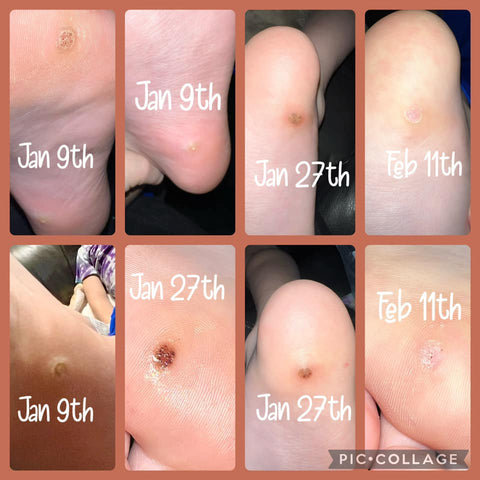Got Verrucas or Plantar Warts?

You might know them as verrucas or you might have come across the term plantar warts but either way they are same skin condition.
Plantar warts and verrucas are the same thing being warts that occur on the bottom of the feet.
This type of wart is contagious and can spread through direct contact or by touching surfaces that an infected person has touched.
More about this type of wart
Each person's body responds differently so not everyone who comes in contact develops warts. Even those in the same family can avoid getting warts.
Plantar warts / Verrucas are not easily transmitted by direct contact from one person to another, the agent does thrive in warm, moist environments — such as shower floors, locker rooms and public swimming areas. So it is always safer not to walk barefoot in such places.
This highly contagious wart agent must have a point of entry into the skin to infect the body. There can be cracks in dry skin, cuts or scrapes or wet and softened fragile skin especially from prolonged water exposure making the foot vulnerable so that plantar warts can result.
A verruca / plantar wart differs from other warts by growing inwards, forming round areas of rough skin with a dry crusty surface and tiny black dots inside.
As they grow, they can become very painful as pressure is applied. It is not long before a plantar wart becomes flattened with pain and discomfort from the pressure of walking.
How do I prevent verrucas or plantar warts?
You can take these steps:
- Keep your feet clean and dry.
- Avoid walking barefoot in public places like pool decks, locker rooms and showers.
- Wear shoes or sandals in public places.
- Avoid sharing shoes or socks with others.
- Disinfect any cuts or scrapes on your feet to prevent infection.
- Avoid touching other people's warts.
It's also a good idea to inspect your feet regularly for signs of warts, such as small, hard bumps on the soles of your feet. Early treatment makes it easier to get rid of these warts and also helps to prevent them from spreading.
How do I tackle verrucas?
You can try these various suggestions:
- An over-the-counter salicylic acid preparation available at the pharmacy in liquid, gel, pad or ointment form. Be sure to follow package directions because over-application of these products can burn the skin. Periodically sand and re-treat the wart. It can take several months to get rid of a large one using these treatments. Soak the affected area in warm water for five minutes before applying the salicylic acid to enhance the effects of the medication. The prolonged use of this medication is not recommended, especially in infants, people with diabetes, or others with circulation problems.
- A commercial preparation containing about 17% salicylic acid and 17% lactic acid in a fast-drying solution that can be applied daily after showering. Once the preparation is dry, the wart is covered with waterproof tape, which is removed after the next shower or bath. Follow the instructions to continue with the method which can take several months to clear the wart.
- Using duct tape is another approach where the tape is applied to the wart so that it is covered twenty four hours a day, six out of seven days a week, for six weeks.
- You can visit your doctor for the plantar wart to be cut out which can be painful and possibly lead to scarring.
H-Warts Formula is gentle and very effective on plantar warts and verrucas. The surface of the plantar wart is targeted, and the root structure is eliminated, so there is no regrowth, burning, pain or scarring.
How do I use H-Warts Formula for my warts?
You apply the product directly to your warts. Because the formula is concentrated, only a few drops are needed for each application. The natural components will counteract the symptoms of warts when used properly and according to instructions which are provided.
SOURCES:
Landis MN, et al. Recalcitrant plantar warts treated with recombinant quadrivalent human papillomavirus vaccine. Journal of the American Academy of Dermatology. 2012;67:e73.
Habif TP. Plantar warts. In: Clinical Dermatology: A Color Guide to Diagnosis and Therapy. 6th ed. Edinburgh, U.K.; New York, N.Y.: Elsevier; 2016. https://www.clinicalkey.com. -(Accessed March 2, 2017).
Kwok CS, et al. Topical treatments for cutaneous warts. Cochrane Database of Systematic Reviews. http://onlinelibrary.wiley.com/doi/10.1002/14651858.CD001781.pub3/abstract.-(Accessed March 2, 2017).
Warts. American Academy of Dermatology. http://www.aad.org/dermatology-a-to-z/diseases-and-treatments/u---w/warts. Accessed March 2, 2017.







